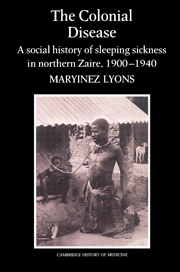Third phase: World War I
The period of the First World War can be considered as the third phase in the campaign against sleeping sickness in the Belgian Congo. Unfortunately, the war began just at the time when the colonial administration was in the process of addressing the problem of a medical service and public health policy in the Congo. An outstanding feature of the period of the war was the manner in which the colonial administration contradicted its own public health policy and, in fact, aggravated human sleeping sickness in northern Congo. The reprise of the Congo in 1908 had not been widely popular amongst Belgians at home but the war revealed, for perhaps the first time, the fact that their government needed the labour and resources available in its colony. Evacuated to Britain because of German occupation, the Belgian government looked to its African colony for material assistance in the war effort. North-eastern Congo was suddenly of great importance for three reasons: gold, rubber and labour. We can get some idea of the effect of the war by examining the figures for gold production in northern Congo during the war. In 1913, the total sales from Kilo-Moto amounted to 4,676,852 francs, but by 1918, the sales were 12,394,256 francs and in 1919, 19,796,000 francs. In six years, the sales had quadrupled.
But the constantly increasing demands for gold, rubber and men forced the colonial administration to contradict much of its own recent public health policy in the north-east. The labour demands required an intensification of the movement of population throughout the northeast, and that meant that the recently imposed cordon sanitaire became a hindrance to the war effort.
